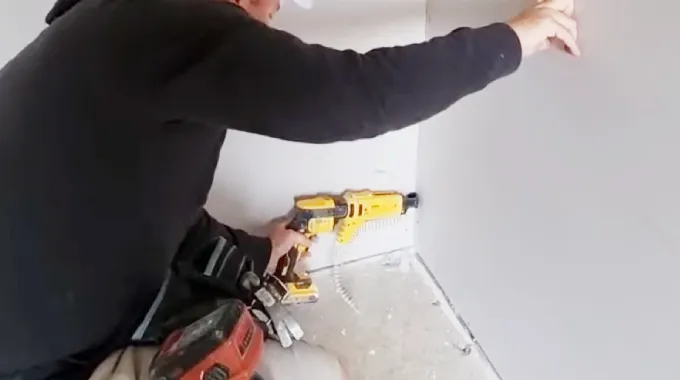Last Updated on March 20, 2023
If you need a quick DIY drywall fix or building project, you may consider reaching for your trusty staple nail gun, but can you use a staple gun on drywall?
Absolutely! Staple guns make affixing items onto your drywalls quick and easy. These handy tools can help you with any drywall home project once mastered.
Though staple guns may at first appear to be a cheaper and quicker alternative to drywall screws for installing drywall, they just don’t hold up. Because these nails lack threads and will wear out over time, often leading to popped-out from drywalls.
Before attempting a home improvement drywall project with staples, learn more about their effectiveness and the potential risks. This blog post uncovers insight into using a staple gun on drywall to ensure an informed decision is made before commencing work.
When Can You Use a Staple Gun on Drywall?
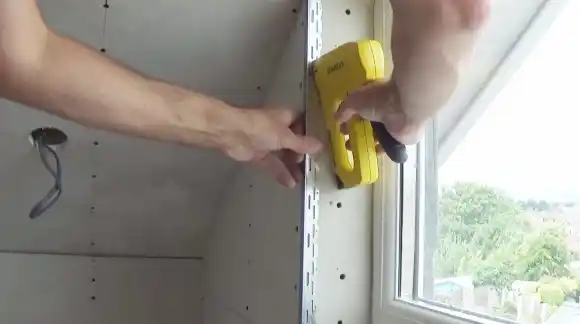
Using a staple gun on drywall is an easy and economical way to attach items or hang decorations on walls. Staple guns are ideal for securely fixing wall boards, installing carpets, affixing objects to drywalls, and repairing materials such as insulation, netting, and fabrics.
For Affixing Items onto Drywalls:
You can use a staple gun on the drywall panels when you attach items that don’t require much strength. This could include lightweight photographs or paper decorations that have been framed. You can ensure a secure hold if the wall is clean and position the staples correctly within the wallboard.
It’s important to note that if you hang heavier items, such as artwork made from canvas or other materials, it’s important to use screws instead of staples for added security.
For Fixing Drywall Angle Bead:
When using angle beads on drywall corners, it is possible to use a staple gun to secure them in place before applying joint compound or mud. Angle bead adds support around the corner edge of walls and prevents cracking along the weak point of corners where two pieces of drywall meet.
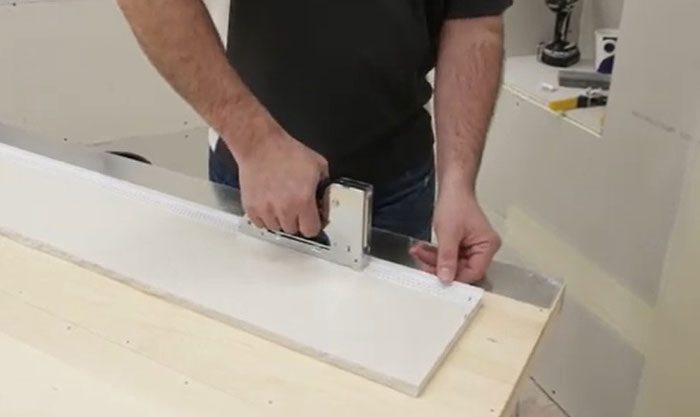
Staple guns make attaching metal corner beads simple but make sure you don’t insert staples too profoundly into the sheetrock as this may cause damage that could affect its performance under heavy impact areas like doorways and hallways.
For Organizing Cords with Zip Ties:
Staple guns can be used when organizing electrical wires and cords with zip ties to keep them out of sight on drywall board while also making them easier to access in case they need untying at some point in time.
Make sure that the cord isn’t pinched by the staple when attaching it so that it doesn’t cause any damage or fraying over time which could be a fire hazard.
You should also remember not to pull too tightly when attaching zip ties around cords, so there’s enough slack for future adjustments without having to cut off the ties completely every time you need access.
When Shouldn’t You Use Staple Guns to Drywall?
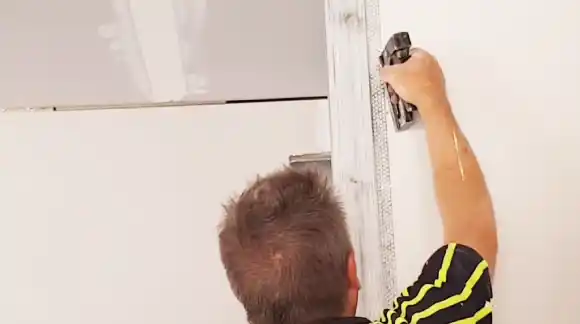
Staple guns are beneficial for attaching materials to drywall, but knowing when not to use them and what situations should be avoided is essential.
Never Use for Installing Drywall
A traditional stapler should never be used for installing drywall, as the staples don’t provide enough holding power (because they are not threaded) to ensure the wall stays secure after being stressed from regular wear and tear or heavier items hung on it.
Instead, use thicker fasteners such as drywall screws which will be much stronger and more reliable. Aside from that, using staples could cause damage to the surrounding drywall board materials as they may be challenging to remove correctly without causing damage to other walls or surfaces nearby.
Never Use on Plasterboard
Staple nails should also never be used on plasterboard as their thin shape means they easily slip out over time due to movement or vibrations caused by everyday activities like footsteps or furniture being moved around.
This results in an uneven and unstable surface that won’t last long and could cause damage if heavier items are placed onto it, or the wall becomes cracked due to poor fastening techniques.
Never Use to Hang Heavy Objects
Stapling is also not suitable for hanging heavy objects on drywall boards such as heavy mirrors or shelves, as the small staples are easily pulled out of the wall material under pressure, leaving gaps between fastenings which could cause significant damage over time if left unchecked.
Instead, use proper anchor screws that will provide more stability over time and reduce the risk of accidents occurring due to sudden shifts in weight distribution caused by unexpected movements around your home.
Never Use Where Moisture or Humidity is High
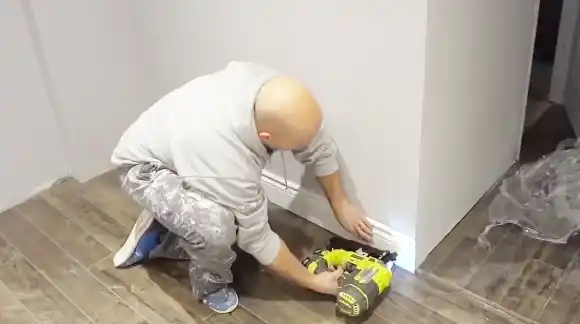
Staple nails shouldn’t ever be used in areas where moisture is present as this causes them to rust quickly and can lead to large amounts of staining on your walls, something nobody wants.
Another reason you should avoid using staple nails in these environments is that humidity can cause staples to warp through an expansion, which reduces their effectiveness significantly.
Avoid Puncturing Electrical Wires
When using a staple gun near electrical wires on drywall, know where exactly you’re aiming before firing off your shots. Due to their powerful firing force, staple guns can easily puncture electrical wires without good accuracy and precision. This could result in serious injury if exposed live wires are encountered during stapling activities.
To avoid this risk, opt for another method of fastening your object into place (Cable ties, zip ties) or take extra care when stapling near electrical wiring/cables. Always double-check where you’re aiming before pressing down on the trigger.
What to Consider When Using a Staple Gun on Drywall?
You need to consider some essential factors when performing a drywall improvement project by using a staple gun to ensure optimum results:
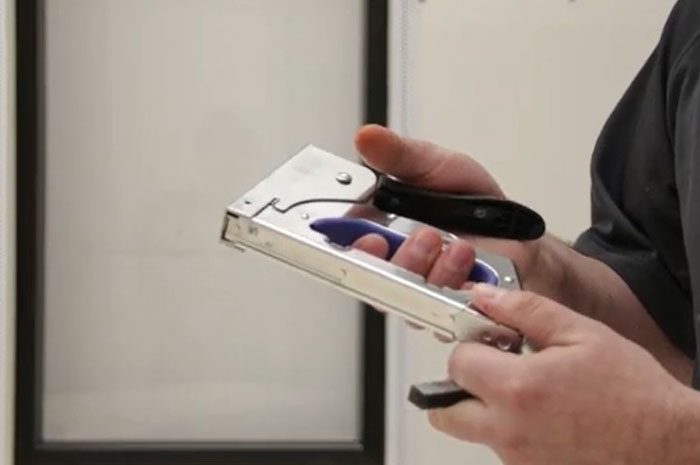
Type of Stapler: Manual or Electric
When considering a staple gun for use on drywall, there are two main types: manual and electric. Manual staple guns are operated by pushing down with your hand, while electric staple guns pull a trigger to operate them.
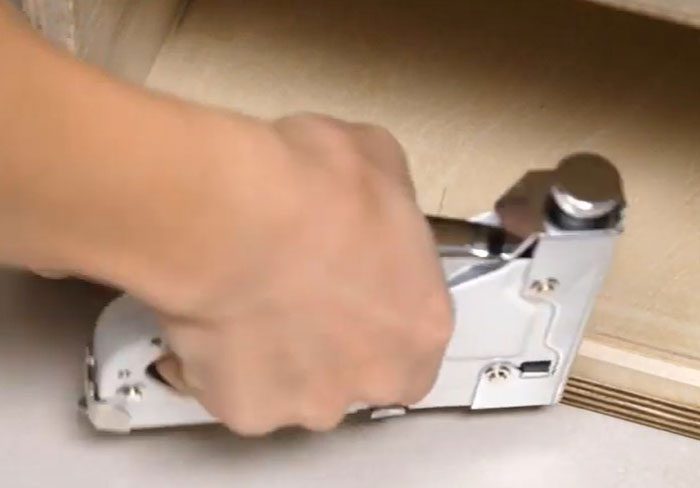
Electric models tend to provide more power and efficiency over manual ones, although they may be heavier and more expensive.
Installing Staple Nails at the Correct Depth

Staple nails must be installed at the correct depth so that they don’t break through the other side of the drywall or end up too shallow and not do their job correctly. Depending on your material, it may require different depths.
Heavier materials will usually require deeper staples. To ensure this is done correctly, adjust the depth setting on the stapler so that each staple is inserted into the drywall at an even depth.
Properly Securing Staple Nails
Once staple nails have been installed into the drywall, they must be appropriately secured. This can be done by tapping them firmly with a hammer until they are flush against the wall and then checking with a level if necessary to ensure they’re even across all surfaces.
It is also essential to check for any loose staple nails after the installation, as these can cause future problems with moisture retention or stability.
Types of Material You Use
When using a staple gun (such as a brad nailer) on drywall, you must consider what type of material you’ll be working with and what type of staples will suit you best.
For example, plastic-coated steel staples work well on gypsum boards, while galvanized steel staples offer better resistance against moisture damage when used on concrete walls. In either case, selecting high-quality materials is good practice to ensure your workmanship’s long-term durability and strength.
What Type of Staple Gun to Use for Drywall?
An air-powered gauge staple gun (such as Bea 22-Gauge Stapler) is the best type to use when attaching drywall. This type of stapler is specially designed to shoot staples with enough force to penetrate the gypsum board and hold it securely in place.
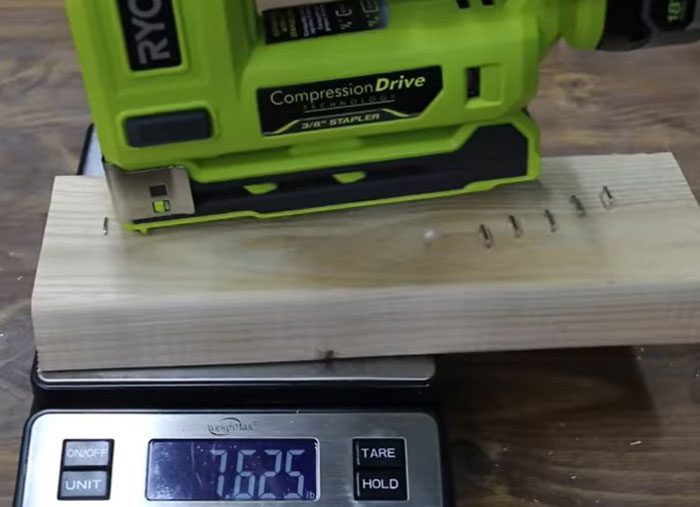
You will need the right size and type of staples to do this job. Some models might be too weak or too wide, which could damage the drywall. Also, using an air-powered stapler ensures consistent firing power, as opposed to manual or electric staplers, which differ in their speeds and levels of force.
Why Shouldn’t You Use Staple Guns to Hang Ceiling Drywall Panels?
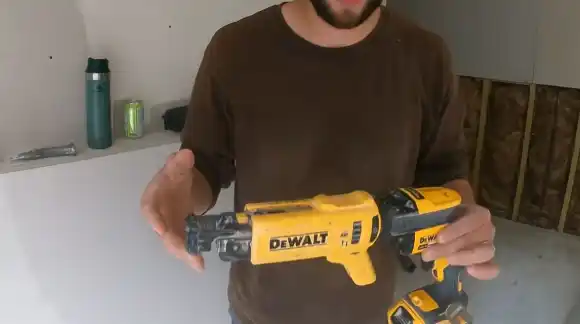
Using a staple gun on ceiling drywall panels should be avoided as the staples may become loose over time, causing them to stick out or pop off altogether. This is partly due to changes in temperature and humidity, which cause different materials within the wall paneling to expand or contract at different rates.
This causes a loosening effect on the staples, making them ineffective at holding up the ceiling paneling. Instead, nails or drywall screws should be used when hanging ceiling drywall panels as they provide greater stability with time and won’t loosen with fluctuations in temperature and humidity levels.
Can You Attach Heavy Objects to Drywall Using a Staple Gun?
It is generally not advised to attach heavy objects such as shelves or cabinets directly into drywall using a staple gun due to the increased risk of potential damage from the weight.
In most cases, it is better to use specialized hardware specifically designed for heavier items, such as anchors or screws, that provide more significant support while distributing weight evenly across multiple points on the wall.
Also, if you’re dealing with heavy items such as wall mirrors, it’s usually best practice to mount them directly into studs to ensure maximum support and stability over time.
Can You Use a Staple Gun to Affix Matting to Drywall?
Using a staple gun is a viable option for attaching matting to drywall. It is an effective way of securely fastening the matting to the wall quickly and easily. But, it is essential to use the correct staple gun and nails for this job.
Using staples that are too large or too small for the job can cause damage to both the matting and drywall. Also, ensure that staples are inserted at least ¾ of an inch from corners or edges to avoid causing any cracks.
When stapling close together, ensure enough space between each one for optimal holding power and prevent cracks in the drywall.
Can the Wrong Type of Staple Gun and Nails Damage the Drywall?
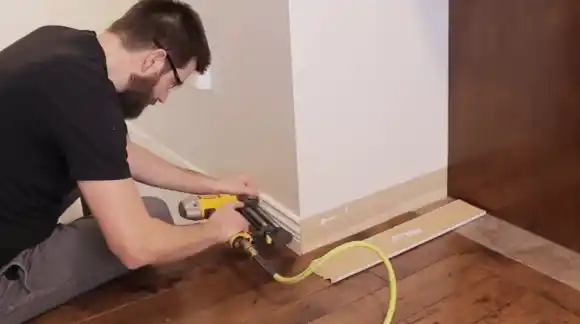
Yes, using the wrong staple gun and nails can cause drywall damage. If the staples are too large, they can tear through the surface of the drywall leading to tears and unsightly marks. Similarly, if they are too small, they may not hold securely and could pull away from the wall over time, causing damage.
Also, if staples are fired too close together, they can create weak points in your walls, leading to cracking when pressure is applied across them. It is, therefore, vital that you use only appropriate-sized fixings with suitable spacing when affixing matting so as not to cause any harm to your walls.
Securely Fix Anything with a Staple Gun on Drywall
The use of a staple gun on drywall can be an effective way to fasten materials and objects securely. By choosing the proper staple gun and nails for the job and considering the weight of the object attached to the drywall, you can ensure that your project will be done expertly and with minimal damage to the wall.
Although there are some drawbacks to using a staple gun on drywall, such as the potential risk of damaging the surface or having staples show through paint or paper, it is still a viable option for many projects.
Specialized staples are explicitly made for drywall use, which can help reduce any adverse effects. With careful preparation and execution, a staple gun on drywall can be a great way to finish your project quickly and securely.
